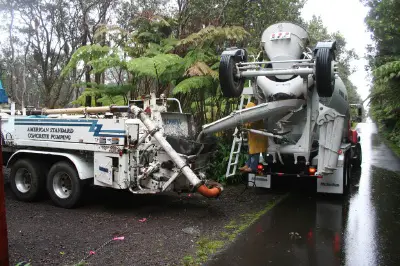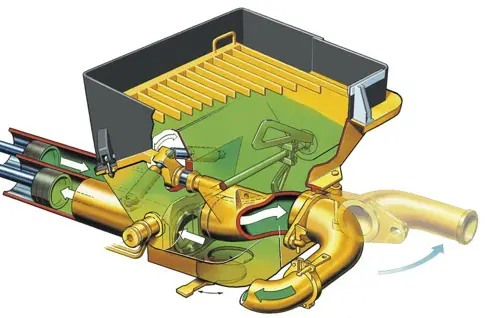HOW DOES A CONCRETE PUMP TRUCK WORK?
If you've ever wondered, "How does a concrete pump truck work?" I'll explain how a concrete pump works and also why to use a concrete pump truck.
We use concrete pump trucks quite frequently to place the concrete for basement floors, large concrete slabs, pool decks and just about anything else we can't reach using the concrete trucks chutes and a 16 foot cold chute.
WHY USE A CONCRETE PUMP TRUCK?
Some advantages for using a pump truck to place your concrete are; the pump truck can reach over houses and into backyards, a pump truck can pump concrete up 2, 3, 4 floors and more, pump trucks place the concrete right where you need it, pumping concrete is fast which saves on labor cost, pumping the concrete reduces the amount of manpower you need to place the concrete.
If you've ever wheelbarrowed 10 - 20 yards of concrete over a long distance or used a concrete powerbuggy to place a 100 yard slab, you know exactly what I mean. You know why it makes sense to use a concrete pump truck.
HOW DO CONCRETE PUMP TRUCKS WORK?
The simple answer to "how concrete pumps work" is, a concrete truck discharges its concrete into a hopper on the back of the pump truck. The hopper has a mesh grate the concrete falls through which prevents any large rocks or chunks from plugging the pump truck hoses. The hopper also has an auger that churns the concrete keeping it liquid and flowable.

Once the concrete is in the hopper, it gets sucked into a valve system in small intervals or strokes. As some of the concrete is being sucked into the valve, the concrete before it is being simultaneously pushed through the concrete pipe on the pump truck boom until it reaches the end of the concrete hose and placed where you need it.
Some concrete pump trucks have different types of valve systems, s-valves, ball-valves, but basically that's how a concrete pump works. As long as the hopper stays full and there are no blockages in the concrete hoses, the process of pumping the concrete goes quite smoothly.
Having a good concrete pump truck operator is also very important. Their experience and wisdom is key to handling any problems that may occur, fixing them, and keeping the pour going.
HOW CONCRETE PUMPS WORK
For a more technical answer as to how a concrete pump works, I'll explain how an S-tube valve system works.
The operation of the concrete pump involves the use of hydraulic and electrical systems. This system incorporates material cylinders linked to hydraulic cylinders that cycle alternately. With concrete mix in the hopper and the pump operating, a material cylinder retracts, drawing material into the cylinder.
At full retraction of the cylinder, a signal is sent to both the S-tube swing cylinder and the drive cylinder directional valves causing the S-tube to shift position to the fully loaded material cylinder and the drive cylinders to change direction. The concrete piston of the loaded cylinder then pushes the material through the S-tube and into the delivery lines.

The shifting from one cylinder to the other cylinder takes place providing a continuous flow of concrete mix through the pump trucks concrete piping system. The pump can be operated at the control panel or can be operated from the remote control.
The hydraulic oil flow created by the hydraulic pump pushes the drive cylinder pistons inside the drive cylinders alternately back and forth. Because the drive cylinders and concrete pistons inside the concrete cylinders are linked together, the pistons move synchronously.
When a drive cylinder retracts along with the concrete piston, concrete will be sucked from the hopper into the concrete cylinder. Simultaneously, the other drive cylinder and concrete piston are extended toward the hopper. The concrete piston will push concrete from the concrete cylinders through the S-Tube and out to the concrete pipe and concrete hoses.
Next, the pump switches at the end of the stroke, causing the s-tube valve to shift to the other concrete cylinder which has sucked and filled the cylinder with concrete, starting the next cycle.
Reverse pumping links the concrete piston in the suction stroke and S-Tube valve to suck concrete from the s-tube instead of the hopper. As a result, the concrete piston pumps concrete back into the hopper. Reverse pumping is mostly used to clean out the concrete hoses after the pour is done.
The power for operation of the concrete pump is provided by the engine, which drives the hydraulic pumps.All functions for operation of the concrete pump can be accomplished from the local controls mounted on the side of the pump truck. Optional hand-held cable or radio remote controls enable the pumping process to be operated from a remote distance. The concrete pump is designed to safely pump wet concrete through a delivery system of pipes and hoses within its published ratings and specifications.
Safety and Stability of the concrete pump during operation is provided by the front and back outriggers. Controls for the outriggers are located on the sides of the concrete pump truck.
I hope this helps clear up any questions you may have had about HOW DOES A CONCRETE PUMP TRUCK WORK. There are a lot of concrete companies that provide concrete pumping services.
You probably have a couple concrete pumping contractors in your local area you can call to talk with about a project you have coming up to see how pumping concrete can save you money and keep the project on schedule.
Return from How Does A Concrete Pump Truck Work to Pumping Concrete
Return from How Does A Concrete Pump Truck Work to Everything About Concrete Home Page














